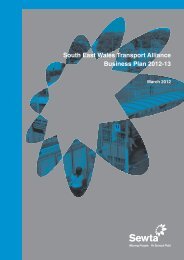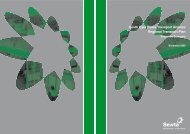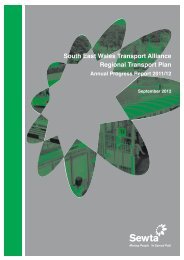Sewta 2013/14 Delivery Plan
Sewta 2013/14 Delivery Plan
Sewta 2013/14 Delivery Plan
You also want an ePaper? Increase the reach of your titles
YUMPU automatically turns print PDFs into web optimized ePapers that Google loves.
<strong>Sewta</strong> RTP <strong>Delivery</strong> <strong>Plan</strong> <strong>2013</strong>/<strong>14</strong>The overall prioritisation of the Regional Transport <strong>Plan</strong> capital programme is set out in the RTP.The RTP considers a number of strategic options and concludes on a Preferred Option, which isshown to be best suited to deliver the RTP objectives and priorities. The Preferred Option assumesthat for the next five years overall effort is roughly split equally between highways (continuation ofexisting schemes, making better use of regional roads network) and public transport (raildevelopment, bus and integration), with a much increased effort (compared to previous years) onwalking & cycling and soft measures.Consequently the RTP Five Year Programme determines that over the five year period availablefunding should be prioritised as 44% highways, 44% bus and PT integration, 8% walking & cycling,2% rail development and 1% other.This prioritisation for the overall regional and local transport capital programme can no longer beachieved. The three main reasons are:1) Availability of funding for new schemes between 2010/11 and 2015/16 is now likely to runat less than 20% of the average of 2004/05-to 2009/102) Welsh Government policy decision to fund the legacy highway programme in full, leavingconsortia to find funding for any other legacy scheme 3 from their allocation for newschemes.3) The requirement in <strong>2013</strong>/<strong>14</strong> for <strong>Sewta</strong> to allocate approximately 31% of the overallRegional Transport Consortia Grant allocation to active travel with a further 26% on matchfunding for the delivery of the Access for All programme.On this basis <strong>Sewta</strong> has concluded that it should prioritise its available funding in <strong>2013</strong>/<strong>14</strong> to reflectthe following proportions:- 31% for Active Travel / Walking & Cycling schemes,- 26% for Rail Access for All,- 32% for <strong>Sewta</strong> Metro Plus schemes (including rail development, bus and integration),- 8% for highways make-better-use schemes, and- 3% for other activities (programme management, monitoring).The following sections set out the prioritisation within the modal subsections.2.5 Prioritisation – Walking & CyclingAs set out in the RTP, <strong>Sewta</strong> previously developed and prioritised a walking & cycling capitalprogramme, which was delivered through Transport Grant bids. However a proportion of thisremained outstanding 4 . From <strong>2013</strong>/<strong>14</strong> onwards the Welsh Government will also no longer providecapital funding to Cardiff City Council for its Sustainable Travel Cities Programme, which meansthat further implementation of the Cardiff Cycle Network will increasingly rely on funding from<strong>Sewta</strong>. The <strong>Sewta</strong> Walking & Cycling Group, consisting of representatives of member councils,Sustrans and the Welsh Government, has reviewed the proposals (as well as any additionalsuggestions) in terms of deliverability (though programme peer reviews), funding needs/co-fundingopportunity 5 , their relationship to the regional cycle network, national and local cycling strategies(where existing) and quality of proposal (through planning peer reviews). A number of schemeshave been deleted from the programme, while some others have been added where they couldshow strong benefits according to prioritisation criteria.For further information on the benefit of individual schemes or elements within schemes see theAnnex 3a form.3 E.g. walking & cycling, public transport4 This was partly caused by the closure of the Transport Grant programme for new proposals in its last years,which hit walking & cycling particularly hard as most walking & cycling schemes are delivered within 1-2years. By 2008/9 spending on walking & cycling had fallen to zero.5 For example, EUSF, Sustrans / lottery funding- 6 -






